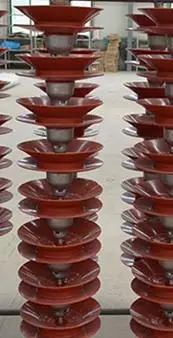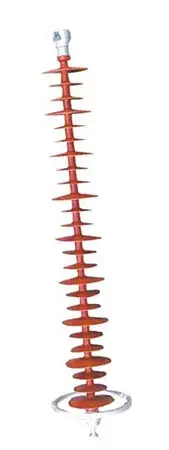Insulators are important items in electrical power lines, they are widely used in all circuits and electrical or electronic systems to isolate electricity between two conductive materials. What we talk about today are polymer insulators and porcelain insulators applied on high voltage overhead lines.

What’s the difference between polymer insulators and porcelain insulators?
First of all, we can easily tell an obvious difference from their names: the materials.
Polymer insulators are made of several parts: the core inside, which cannot be seen from appearance, is made of fiberglass. The outer part, which we can see in red or grey color sometimes, is made of silicon rubber, that’s why it is called “polymer”. While on the top and bottom, a polymer insulator usually has 2 ends with metallic material, they are called “fittings”. The fittings are made into shapes with a standard connection, these enable the insulators to be connected to other insulators or accessories in overhead lines.
Let’s see the composition of porcelain insulators. Porcelain insulators are also known as ceramic insulators, so definitely, the major part is made of porcelain. Here the major part means the insulating part, where we see many sheds and grooves. These insulator sheds are manufactured into such shapes to increase the insulating surface, which we call “creepage distance”. On the top and bottom ends, ceramic insulators also have 2 metal fittings, serving for the same purpose as mentioned above.
Apart from the difference in material, here is something more important: the properties and performance.
Porcelain is a fine material for insulation, people discovered this property a long time ago, and that’s why porcelain has been used on high voltage insulators in the first place. As the technology develops, silicon rubber has come into our sight, it has even better insulation performance. Besides, silicone rubber has excellent hydrophobicity and Hydrophobic mobility. This means when dirt and dust accumulate on the surface of insulators, especially in the outdoor environment, the loss of insulation performance becomes more obvious. Hydrophobicity and hydrophobic mobility of silicone rubber insulators prevail.
The mechanical performance of polymer insulators and porcelain insulators differ too.
Porcelain insulators, especially post type porcelain insulators, have better performance on cantilever load. This comes from the physical components of rigid porcelain material. Compared to ceramic core of porcelain insulators, post type polymer insulators have a core of FRP, which is made of tens of thousands of fiberglass filament, and glued by epoxy resin. This may reach the same specified mechanical cantilever load, but due to its properties, it has a better deformation and displacement. This is not preferred in high voltage power substations.
For suspension and tension type insulators, the FRP core shows its advantage in tensile performance. The filament provides an excellent property in bearing tensile strength in the radial direction.

How to identify if an OHTL insulator is good or not?
To identify if an overhead transmission line insulator can meet the mechanical requirements, we need a testing machine for insulators. In the below link, we list an easy and convenient test equipment of insulators, which is designed to inpect tension load and cantilever load of insulators (ceramic and polymer) below 36KV. We will discuss the test methods and acceptance criteria in other articles on this site. Please add our website Contune International Co.,Ltd to Favariotes. There is much knowledge of high voltage electricity here.
Insulator Test Machine of Tension & Cantilever | ContuneINTL (contune-intl.com)
